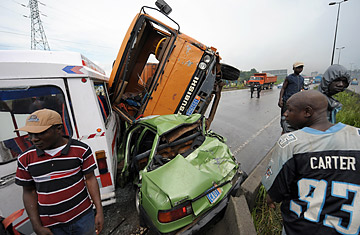
People stand near an accident in which a car was smashed between a truck and a bus near Abidjan, Ivory Coast
World Health Organization, 287 pages
The Gist:
The WHO's first-ever report on worldwide road safety calls attention to a growing global health and development problem — and finds that 85% of the world's countries are woefully unprepared to address it. More than 1.2 million people are killed annually in car accidents, making vehicular injuries the ninth leading cause of death in 2004. Without stricter laws and better safety precautions, car crashes are expected to become the fifth deadliest killer by 2030. Aside from the obvious human costs, the report notes that unsafe roads make a significant dent in the world economy.
Highlight Reel:
1. On why pedestrians, cyclists and motor bikers are at risk: "In many countries roads are planned and built to allow motor vehicles to travel faster ... insufficient thought is given to the needs of pedestrians and cyclists, which means that these vulnerable road users face increasing risks in using and crossing the roads. This global survey shows that pedestrians, cyclists, and riders of motorized two-wheelers and their passengers account for around 46% of global road traffic deaths."
2. On how traffic injuries burden hospitals: "Road traffic injuries place a huge strain on health care services in terms of financial resources, bed occupancy, and demand placed on health professionals. In Kenya, for example, road traffic injury patients represent between 45-60% of all admissions to surgical wards. Similarly, studies in India show that road traffic injuries account for 20-50% of emergency room registrations, 10-30% of hospital admissions, and 60-70% of people hospitalized with traumatic brain injuries."
3. On the economic impact of car accidents: "The road traffic injury epidemic also has considerable impact on the economies of many countries, particularly low-income and middle-income countries that are frequently struggling with other development needs. The global losses due to road traffic injuries are estimated to be U.S. $518 billion and cost governments between 1% and 3% of their gross national product — more than the total amount that these countries receive in developmental assistance."
The Lowdown:
At first glance, the report confirms what you probably already knew: health-wise, you're better off living in a rich country than in a poor one. Though they're home to less than half of the world's vehicles, low- and middle-income countries account for more than 90% of traffic fatalities. But the economic findings are more surprising — and they're worth paying attention to. The WHO offers some intuitive fixes: buckle down on speed limits, reduce drunk driving and tighten seat-belt laws. Others are less obvious — particularly the recommendations that tackle car safety by focusing on pedestrians and "vulnerable road users." More analyses of land use and road design are needed. Otherwise, walking remains unsafe at any speed.
The Verdict: Skim
